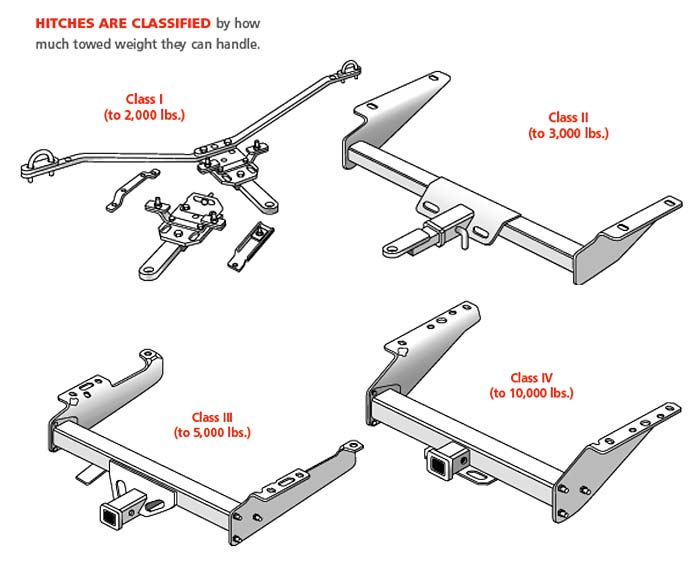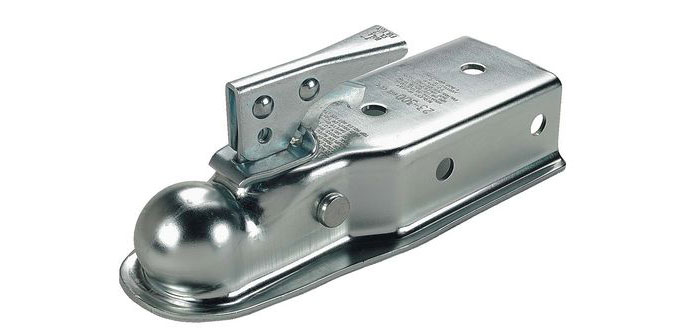Advertisement
The tow vehicle and the trailer are connected in five different places, and each is important. Here's what you need to know.

Photo: Matthew Borkoski Photography
The Hitch And Receiver
There are four types of hitches, each measured by the weight it can pull. Every hitch has a weight capacity (WC) or weight distribution (WD) sticker telling you what loads can be carried.
Tip
Some boats and trailers will require a tow vehicle to have a weight distribution hitch so that some of the weight on a tow vehicle's rear axle is shifted to the front axle.
Class I: Capacity is 2,000 pounds
Class II: Capacity is 3,500 pounds.
Class III: Capacity is 6,000 pounds.
Class IV: Capacity is 10,000 pounds.

There was a time when a trailer ball was a permanent part of a pickup truck and the result was a lot of skinned shins from people who forgot it was there. Today, the trailer ball can be removed because most new tow vehicles’ hitches use a draw bar receiver, to which the ball mount and hitch ball are attached and secured with a hitch pin. Most receivers are either 1 1/4 inches by 1 1/4 inches (1,000 pounds-2,000 pounds), or 2 inches by 2 inches (3,000 pounds-4,000 pounds), though larger boats (read: heavier) will require a receiver hitch with 2 1/2-inch dimensions. See hitch illustrations at right.
The Coupler
A coupler is at the end of the trailer tongue; and this is what rests on the hitch ball and is secured with either a latch lever or, if an older trailer, a round "hand wheel" that is simply screwed down to tighten. Most levers have a locking pin to keep the trailer secured to the tow vehicle. Alternatively, use a small padlock for extra security. Always check that this is tightened/locked before going on the road.

When choosing a replacement coupler for your trailer, consider what type of trailer tongue you have and what the gross trailer weight is.
Breakaway Cable
This cable runs from the actuator's master cylinder to the tow vehicle. It can be considered the last line of defense should the boat trailer separate from the tow vehicle. Its job is to slow the trailer down should the safety chains/cables fail. Should this occur, the cable actuates the brakes, even if the cable should snap off or the coupler come off the tow vehicle. As a result, the breakaway cable must be attached to the tow vehicle hitch — never to the safety chains.
Tip
Electrical
Your boat trailer lights are powered by the tow vehicle's battery so when the trailer is properly connected to the tow vehicle, the trailer lights are on when the tow vehicle lights are on. A harness or connector is used to get electricity from the truck to the trailer.
Tip
There is no single connection or harness that will work with every trailer and tow vehicle. If your tow vehicle is new, chances are good you have a 7-way connector (they range from 4-way to 7-way). It may be necessary to buy an adapter/converter to "connect" the truck to the trailer lights. One common adapter is a "7-way to 5-flat," which means the seven electrical outlets on the truck "adapt" to five electrical pins on the trailer's light system.
Safety Chains
Safety chains or cables are attached to both the trailer and tow vehicle. They have to be crisscrossed to work properly.
Tip
The chains/cables are used to "catch" the trailer tongue in the rare event it separates from the trailer ball and before it hits the pavement. Safety chains should be secured with a snap shackle because it is less likely to come loose than the common "S" hook. The length must allow the tow vehicle and trailer to make tight turns.
